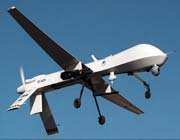WAR BY UAV

As you read this, the odds are good that there's a U.S. unmanned aerial vehicle (UAV) on a mission somewhere over Afghanistan or Pakistan.
The MQ-1 Predator UAV used most commonly by the military and CIA is about the size of a small Cessna prop plane. It's equipped with at least three different types of cameras that record full-motion video. It can fly up to 454 miles at a maximum height of 25,000 feet and at a speed up to 135 mph. Following the September 11th attacks and the hunt for Osama bin Laden, the Predator was equipped with two AGM-114 Hellfire anti-tank missiles.
Rudimentary pilotless flying machines were first attempted by soldiers in the Civil War, and unmanned aerial vehicles (UAVs) have been used by the U.S. military as surveillance tools since the 1950s. Other types of U.S. UAVs include the MQ-9 Reaper, three times faster than the Predator and capable of carrying 15 times more firepower, and the RQ-4 Global Hawk, the first pilotless aircraft to fly non-stop across the Pacific. In the Gulf War, Iraqi soldiers allegedly surrendered to a unmanned aerial vehicle, marking perhaps the first time in history that man surrendered to a robot. Today, the Air Force has 195 Predators and 28 Reaper UAVs in its fleet.
The Predator and its cousins are controlled remotely by a two- or three-person teams: a pilot and one or two sensor operators. Most of the CIA's Predators are flown by teams at Langley Air Force Base in Virginia, while the Air Force's UAVs are run out of Creech Air Force Base in Nevada, where pilots hunker down in air-conditioned trailers in front of multiple screens streaming live video. Both locations are more than six thousand miles from their target zones in Iraq, Afghanistan and Pakistan.
In the past year, under pressure from citizens, the Pakistani government has publicly protested the U.S. use of UAVs while simultaneously requesting control of the planes. Controversy surrounding the use of UAVs has mounted, with critics faulting the UAV campaign for alienating Pakistani citizens and providing recruitment propaganda for the Taliban. The tension has continued to build as the Pakistani Army begins to take on the Taliban near the capital, Islamabad. The CIA and the military do not confirm UAV missile strikes in Pakistan, but some reports claim that up to 370 people have been killed since UAV attacks intensified in August 2008. A recent LA Times Op-Ed quotes a counterinsurgency official claiming the elimination of 14 senior Al Qaeda operatives by UAV attacks since 2006. The official places the civilian death toll during this time at around 700.
Resources
- A short history of UAVs
- Listen to NPR interviews with Predator pilots
- The MQ-1 Predator, America's most popular UAV
- Our blog coverage of UAVs in the news
- Background on UAVs from a recent New York Times story
- A recent Pakistani newspaper report on civilian casualties caused by UAVs



Comments
wow! its wonderful and educational about Remote-Control War.
KRYSTIAN / September 3, 2009 8:25 PMWe Shouldn't have to risk our life's.
Anonymous / September 20, 2009 2:31 AM